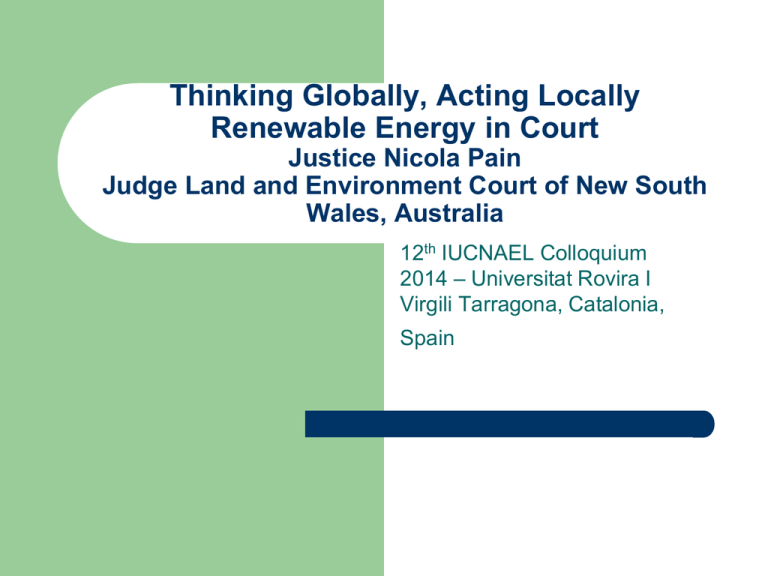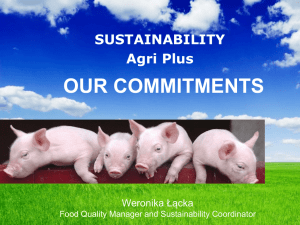Thinking Globally, Acting Locally
advertisement

Thinking Globally, Acting Locally Renewable Energy in Court Justice Nicola Pain Judge Land and Environment Court of New South Wales, Australia 12th IUCNAEL Colloquium 2014 – Universitat Rovira I Virgili Tarragona, Catalonia, Spain “First, the extent to which sustainable energy technologies are adopted in Australia and elsewhere depends on a variety of largely unrelated factors. The most important of these are the degree of research activity conducted by private and public research institutions, the level of government assistance provided, the economics of renewable energy and energy efficient technologies, the degree of social acceptance of alternative energy technologies and the level of public education in issues of sustainable development. Another important, and sometimes overlooked, factor is the role of the law.” Rosemary Lyster, Adrian Bradbrook, Energy Law and the Environment, 2006, Cambridge University Press, at 2.4.1 “Planning law is the framework under which land use conflicts are resolved through development controls and is at the forefront of balancing local concerns and development which address wider national and global objectives.” Lisa Caripis and Anne Kallies, “Planning away” Victoria’s renewable energy future? Resolving the tension between the local and global in windfarm developments, (2012) 29 EPLJ 415 at 417 Government Regulation Delivery of national/state renewable energy targets Infrastructure legislation Planning legislation National/state or provincial planning Local/municipal planning Wind farms in VCAT Perry v Hepburn Shire Council (2007) 154 LGERA 182 Planning instruments included evaluation criteria for wind farms Contribution to achievement of state and national renewable energy goals recognised Tribunal took into account • the benefits of renewable energy generation and reduction of greenhouse gases • identified limited data on benefits • noise and visual impacts considered acceptable • impacts on birds considered acceptable Wind farms in VCAT (cont) Bald Hill Windfarm Pty Ltd v Minister for Planning [2012] VCAT 1092 Applicant for consent had existing permits but required ministerial approval of development plans Minister delayed in approving Minister’s case that the court action premature not accepted Noise criteria could be met at neighbouring properties Wind farms in VCAT (cont) Cherry Tree Wind Farms Pty Ltd v Mitchell Shire Council [2013] VCAT 521 Visual impact of wind farm acceptable Main issue whether human health effects resulting from low pressure frequencies Proceedings adjourned to enable more investigation pending outcome of inquiry by SA EPA Wind farms in ERD court of SA Quinn v Regional Council of Goyder & Anor [2010] SAERDC 63 Third party objector appeal against development consent for wind farm by local council Planning controls included state wind farm assessment factors Local plan required that weight be given to visual impact on landscape character of development Issues of visual amenity and noise impacts Held that some areas of state had such significant landscape quality a wind farm was not appropriate/impact in this area of primary production acceptable Wind farms in ERD court of SA (cont) Paltridge v District Council of Grant [2011] SAERDC 23 Third party objector appeal against decision to approve wind farm. Land zoned primary industry with objectives of maintaining the rural landscape Court acknowledged state government policies aimed at reduction of greenhouse gases and promotion of renewable energy; focus of assessment was the local council development plan Issues of noise including infrasound, health impacts and visual amenity Possible noise and health impacts not established Wind farm refused because of the large number of discordant visual elements introduced into the landscape by the turbines Wind farms in the LEC Taralga Landscape Guardians Inc v Minister for Planning and RES Southern Cross Pty Ltd [2007] NSWLEC 59; (2007) 161 LGERA 1 Third party objector appeal against state significant development Local council planning controls not mandatory Policy context recognised by the Court as supporting renewable energy generation in sustainable development principles including intergenerational equity, national mandatory renewable energy target Issues of noise, visual impact considered Held that overall public benefit outweighed any private disbenefits to the Taralga community or specific landowners Wind farms in the LEC (cont) King v Minister for Planning; Parkesbourne-Mummel Landscape Guardians Inc v Minister for Planning; Gullen Range Wind Farm Pty Limited v Minister for Planning [2010] NSWLEC 1102 Third party objector appeals against state significant development Local council planning controls not mandatory/local planning control requiring minimum 2 km distance of turbines from houses not warranted Issues of noise, blade flicker, unacceptable visual impact, inadequate provision for land acquisition or compensation Impact acceptable Economic benefit of development in the community through provision of jobs recognised Desirability of encouraging renewable energy as recognised in Taralga and in light of increasing scientific evidence from bodies such as IPCC Requirement of community enhancement program as part of conditions of approval Wind farms in the Environment Court New Zealand Consideration of landscape significance well developed Pigeon Bay Aquaculture Ltd v Canterbury Regional Council [1999] NSRMA 209 (Env C) the natural science factors – the geological, ecological and dynamic components of the landscape; its aesthetic values including memorability and naturalness; its expressiveness (legibility): how obviously the landscape demonstrates the formative processes leading to it; transient values: occasional presence of wildlife; or its values at certain times of the day or of the year; whether the values are shared and recognized; its value to tangata whenua; its historical associations. Wind farms in the Environment Court New Zealand (cont) Pigeon Bay factors applied in many cases Unison Networks Ltd v Hastings District Council (2009) NZEnvC W11/2009 23 February 2009 Visual impact on Te Waka range considered Rangitikei Guardians Society Inc v ManawatuWanganui Regional Council [2010] NZEnvC 14 Visual impact on Tongariro National Park including Mr Ruapehu considered Wind farms in Ontario Hanna v Ontario (Attorney General) 2010 ONSC 2660 (Ont. Div. Ct.) unsuccessful judicial review challenge to making of regulation under the Environment Protection Act which mandated a minimum distance between wind turbines and residential homes whether the Minister applied a precautionary, science-based approach in decision-making to protect human health and the environment in making the regulation applicant relied on medical evidence to support a submission of scientific uncertainty about the health effects of industrial wind turbines to argue that the precautionary principle required resolution of that scientific issue before setting regulatory standards Hanna v Ontario (Attorney General) 2010 ONSC 2660 (Ont. Div. Ct.) (cont) The Supreme Court identified long-standing policy of Ontario government to reduce annual greenhouse gas emissions including by replacing coal-fired electricity generation by increasing renewable energy sources such as industrial wind turbines Minister required to consider numerous principles not precautionary principle alone Health considerations of persons living in proximity to wind turbines while important did not trump all other considerations Availability of appeal rights for dissatisfied landowners to the Environmental Review Tribunal relevant Minister had followed the process mandated requiring full public consultation and considered science-based evidence in his decision Application of precautionary principle did not preclude decision of Minister Wainfleet Wind Energy Inc v Wainfleet (Township) 2013 ONSC 2194 Unsuccessful judicial review challenge to town by-law requiring setback for wind turbines of two kilometres from property Court held property was broadly defined and too uncertain to enable effective interpretation In obiter reasoning the Court considered the provincial law in the GEA and amendments made to the EPA Act and Planning Act to facilitate renewable energy projects Wind farm cases Balancing global benefits with local concerns Evolving controls developed across jurisdiction Expertise of different jurisdictions drawn on Extent of dominance of local views Geothermal energy projects in the Environment Court New Zealand Rotokawa Joint Venture Limited and Mighty River Power Limited and Taupo District Council v Waikato Regional Council EnvC Auckland A41/2007 Renewal of consent to operate two geothermal power plants, one of which third oldest plant in the world dating from 1958 Solar panels in VCAT John Gurry & Associates Pty Ltd v Moonee Valley CC [2013] VCAT 1258 proposed development of 14 dwellings in Melbourne suburb Objection due to overshadowing of neighbour’s solar panels Factors to consider in assessing whether unacceptable overshadowing • whether the impact is reasonable rather than requiring no overshadowing at all • what constitutes legitimate expectations in light of strategic planning controls and policies affecting the land • whether the solar panels have been placed in an unreasonably vulnerable position on the host building. • whether the placement of solar panels on the host building due to constraints arising from heritage controls • the type of panel and what its operation required • the extent of evidence of overshadowing and how long ago were the existing solar panels installed on the host building.










